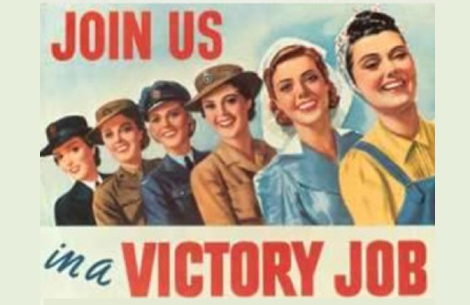Women's Equality Day, the 19th Amendment (which guaranteed a woman's right to vote), and the Equal Pay Act are all early steps that have led to shaping gender equality in today's work force. In recognition of Women's Equality Day, the recruiting experts at America's Job Exchange take a look at the history of women and work.
To truly look at the evolution of women's roles in the working world, let's backtrack to the early 19th century, when the economy in the United States was based on family farms rather than manufactured goods. In these days, the duties were split evenly between husbands and wives; the household couldn't thrive without them both. While men were out in the fields doing physical labor, women remained indoors, producing clothing, preparing and preserving food, and doing other, what would be called today, "domestic" tasks.
However, the farm economy began to be replaced by a market economy with the dawn of industrialization. This meant that household goods, such as clothing or prepared foods, could simply be purchased instead of made from scratch. Women's "domestic" work shifted, and Americans began to look at the man/woman dichotomy in a whole new light. With the emergence of a new industrialized society, new rules followed.
The general consensus at the time was that men were more capable of dealing with the competitive work world they now found themselves thrust into. Women, it was assumed, were unable to handle the pressures of life outside of the home. They couldn't vote, were discouraged from working, and were excluded from politics. Their duty to society was raising moral children, and passing on the values that were unjustly thrust upon them as society began to modernize.
We've come a long way since then. The 19th Amendment, ratified in 1920, legalized women's suffrage, or right to vote. The Equal Pay Act put into law by President John F. Kennedy in 1963 helped ensure equal earnings for both men and women by illegalizing discrimination based on sex. When the Equal Pay Act was signed, women were earning about 59 cents to a man's dollar. The gap has lessened, but, unfortunately, has not disappeared entirely. Women are still earning, on average, about 80 cents to the dollar, sometimes even less in the case of minorities.
Regardless, today women clearly demonstrate not only competence, but also excellence in a working world that was thought by so many as only meant for men. The female presence in the workforce, whether in accounting, the sciences, human resources, developing corporate communications, or assuming executive positions, is increasing in just about every industry. According to statistics from the U.S. Department of Labor, women comprise 47 percent of the total U.S. labor force.
Women are using their skills and abilities in many industries to maximize their career and annual pay. In fact, the Bureau also reports that young women are more likely than men to have a college degree. Women can expect to earn great salaries and compete just as successfully with men in today's working world.
Not Authorized
You are currently not authorized to access this section.
Please contact your Administrator to change your authorization settings.
Please contact your Administrator to change your authorization settings.


